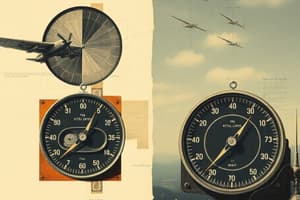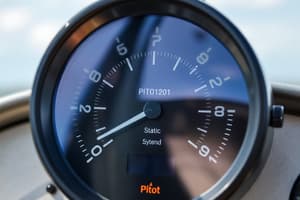Podcast
Questions and Answers
What is the difference between variation and deviation in compass errors?
What is the difference between variation and deviation in compass errors?
Variation is the angular difference between true north and magnetic north, while deviation is the difference between the indicated magnetic heading and the actual heading due to other magnetic fields.
Explain the term 'magnetic dip' and its significance in navigation.
Explain the term 'magnetic dip' and its significance in navigation.
Magnetic dip refers to the tendency of the compass needle to point downward toward the magnetic pole, which causes significant errors especially near the poles.
How do acceleration and deceleration affect compass readings in the northern hemisphere?
How do acceleration and deceleration affect compass readings in the northern hemisphere?
In the northern hemisphere, acceleration shows a turn to the north while deceleration shows a turn to the south, particularly pronounced on east and west headings.
What does the acronym 'UNOS' signify in relation to turning errors?
What does the acronym 'UNOS' signify in relation to turning errors?
Signup and view all the answers
Identify two engine instruments and their primary functions.
Identify two engine instruments and their primary functions.
Signup and view all the answers
What is the primary purpose of the Turn Coordinator (TC) in an airplane?
What is the primary purpose of the Turn Coordinator (TC) in an airplane?
Signup and view all the answers
Explain the difference between a skid and a slip in relation to the Turn Coordinator.
Explain the difference between a skid and a slip in relation to the Turn Coordinator.
Signup and view all the answers
How often should the Heading Indicator (HI) be aligned with the magnetic compass, and why?
How often should the Heading Indicator (HI) be aligned with the magnetic compass, and why?
Signup and view all the answers
What is the role of the magnetic compass in an aircraft?
What is the role of the magnetic compass in an aircraft?
Signup and view all the answers
Describe the components of the Turn Coordinator and their functions.
Describe the components of the Turn Coordinator and their functions.
Signup and view all the answers
What are the two types of pressure used in pitot-static instruments to measure airspeed?
What are the two types of pressure used in pitot-static instruments to measure airspeed?
Signup and view all the answers
What does the green arc on the Airspeed Indicator represent?
What does the green arc on the Airspeed Indicator represent?
Signup and view all the answers
How is Calibrated Airspeed (CAS) calculated?
How is Calibrated Airspeed (CAS) calculated?
Signup and view all the answers
What is the purpose of a pitot heater on aircraft?
What is the purpose of a pitot heater on aircraft?
Signup and view all the answers
Describe what VSO stands for in terms of aircraft speed.
Describe what VSO stands for in terms of aircraft speed.
Signup and view all the answers
What does the yellow arc on the Airspeed Indicator signify?
What does the yellow arc on the Airspeed Indicator signify?
Signup and view all the answers
Define True Airspeed (TAS) in the context of flight measurement.
Define True Airspeed (TAS) in the context of flight measurement.
Signup and view all the answers
What is indicated by the red line on an Airspeed Indicator?
What is indicated by the red line on an Airspeed Indicator?
Signup and view all the answers
What is maneuvering speed and why is it significant for pilots?
What is maneuvering speed and why is it significant for pilots?
Signup and view all the answers
How does an altimeter measure altitude and what does it indicate?
How does an altimeter measure altitude and what does it indicate?
Signup and view all the answers
Explain the difference between indicated altitude and true altitude.
Explain the difference between indicated altitude and true altitude.
Signup and view all the answers
Why is the Vertical Speed Indicator (VSI) considered almost useless in turbulent conditions?
Why is the Vertical Speed Indicator (VSI) considered almost useless in turbulent conditions?
Signup and view all the answers
What are the characteristics of a gyroscope that are important for flight instruments?
What are the characteristics of a gyroscope that are important for flight instruments?
Signup and view all the answers
What role does the vacuum system play in gyroscopic instruments?
What role does the vacuum system play in gyroscopic instruments?
Signup and view all the answers
Describe the function of the attitude indicator (AI) in aviation.
Describe the function of the attitude indicator (AI) in aviation.
Signup and view all the answers
What happens to the altimeter reading if the static port is blocked?
What happens to the altimeter reading if the static port is blocked?
Signup and view all the answers
Study Notes
Aircraft Instruments
- Instruments are used to ensure precise aircraft operation, maximize performance, and enhance safety.
Pressure Instruments (Pitot-Static System)
- Rely on air pressure differences to measure speed and altitude
- Use a combination of impact/ram air pressure and static pressure.
- Pitot tube: Supplies ram air pressure; mounted on the wing or nose section; exposed to the relative wind; increased airspeed increases ram air pressure; susceptible to icing, most aircraft are equipped with a pitot heater.
- Static port: Allows static pressure to enter the system; mounted on the side of the fuselage in an area of relatively undisturbed air
Airspeed Indicator (ASI)
- Indicates the speed at which the airplane is moving through the air.
- Uses both pitot and static pressure; speed is determined by comparing ram air with static air pressure.
- Greater the differential, the greater the speed.
- Divided into color-coded arcs:
- Green arc: Normal operating range
- White arc: Flap-operating range
- Yellow arc: Caution range, only in smooth air
- Red line: Never-exceed speed
Types of Airspeed
- Indicated airspeed (IAS): Actual airspeed reading.
- Calibrated airspeed (CAS): IAS corrected for installation and instrument errors.
- True airspeed (TAS): Airspeed corrected for non-standard pressure and temperature.
- Groundspeed: Speed of aircraft relative to the Earth's surface.
V-Speeds (Speed Limitations)
- VSO: Stalling speed in landing configuration (flaps and gear down).
- VS1: Stalling speed in a specified configuration ("clean").
- VFE: Maximum speed with flaps extended.
- VNO: Maximum structural cruising speed.
- VNE: Never exceed speed.
- VLO: Maximum speed for lowering or extending/raising landing gear.
- VLE: Maximum speed with landing gear extended.
- VA: Maneuvering speed; maximum speed for abrupt control movements without structural damage.
Altimeter
- Measures the vertical elevation above a given reference point.
- Senses pressure changes and displays altitude in feet.
- 3 pointers/hands indicate altitude:
- Longest: Hundreds of feet
- Middle: Thousands of feet
- Shortest: Tens of thousands of feet
- Contains aneroid wafers that expand and contract with changes in atmospheric pressure from the static source.
Types of Altitude
- Indicated: Altitude read directly from the altimeter.
- Pressure: Altitude when the barometric scale is set to 29.92 inHg.
- True: Actual height above mean sea level.
- Density: Pressure altitude corrected for non-standard temperature.
- Absolute: Actual height of the aircraft above the Earth's surface.
Altitude Terminology
- QNH: Local/station pressure.
- QNE: Standard pressure.
- QFE: Field elevation.
Vertical Speed Indicator (VSI)
- Indicates the rate at which the aircraft is climbing or descending in feet per minute (fpm).
- Almost useless in turbulent conditions due to a 6-9 second lag.
Pitot-Static System Blockage
-
Pitot tube blocked:
- ASI reads high in climb, low in descent.
-
Static port blocked:
- ASI reads low in climb, high in descent.
- ALT freezes.
- VSI reads zero.
Gyroscopic Instruments
- Revolve around a rapidly spinning wheel (gyro).
- Gyroscopes have two key properties:
- Rigidity in space: The spinning wheel remains in a fixed position in its plane of rotation.
- Precession: The gyro reacts to forces 90 degrees in direction of rotation from the point of application.
Vacuum System
- Engine-driven or electrically driven.
- Controls the vacuum pump for the system.
- Suction gauge: Monitors available vacuum pressure in the system.
Attitude Indicator (AI)
- Indicates the actual attitude of the aircraft relative to the Earth's horizon.
- Often referred to as the "master instrument."
Turn Coordinator (TC)
- Indicates rate and quality of turn.
- Serves as an emergency bank indicator if the Attitude Indicator fails.
- Combination of a miniature airplane and an inclinometer (ball).
- Facilitates establishment and maintenance of constant rate turns (standard rate turn: 3 degrees per second).
- Does not provide pitch information.
- Modern version of the Turn and Slip Indicator.
Skid and Slip
- Skid: The rate of turn is too great for the angle of bank; the ball is outside the turn; excessive rudder pressure.
- Slip: The rate of turn is too slow for the angle of bank; the ball is inside the turn; insufficient rudder pressure.
- To correct, apply rudder pressure on the side the ball is exposed, i.e., "step on the ball".
Heading Indicator (HI)
- Senses airplane movement and displays heading based on a 360-degree azimuth (final zero omitted).
- Primary source of heading information when set.
- Indirectly indicates bank.
- No automatic north-seeking system.
- Align with magnetic compass every 15 minutes due to precession (straight and level, unaccelerated flight).
Magnetic Instruments
-
Magnetic compass:
- Only direction-seeking instrument in the airplane.
- Primarily used to set the Heading Indicator before flight and verify its continued accuracy during flight.
- Readings are accurate only in straight and level, unaccelerated flight.
- The magnet aligns itself with the Earth's magnetic fields.
Compass Errors
- Variation: Difference between true and magnetic north.
- Deviation: Difference between the indicated magnetic heading and the actual heading, caused by other magnetic fields in the airplane.
- Magnetic dip: Compass needle pointing down towards the magnetic poles; greatest at the poles and zero at the magnetic equator.
-
Acceleration errors:
- Acceleration in the Northern Hemisphere shows a turn to the north, deceleration shows a turn to the south.
- Most pronounced on headings of east and west.
- Does not occur when flying directly north or south ("ANDS - accelerate north, decelerate south").
-
Turning errors:
- Compass leads or lags the actual heading during turns.
- In the Northern Hemisphere, it will indicate a turn to the west if a right turn is entered from a heading of north, while a left turn will indicate a turn to the east.
- Most pronounced when turning from headings of north or south ("UNOS - undershoot north, overshoot south").
- Compass card oscillation: Erratic movement of the compass card caused by turbulence or rough control technique.
Engine Instruments
- Tachometer: Measures engine speed.
- Oil temperature gauge: Measures oil temperature.
- Oil pressure gauge: Measures oil pressure.
- Fuel quantity gauge: Measures fuel level.
- Fuel flow indicator: Measures fuel consumption.
- Exhaust gas temperature gauge: Measures exhaust gas temperature.
- Manifold pressure gauge: Measures manifold pressure.
- Cylinder head temperature gauge: Measures cylinder head temperature.
Studying That Suits You
Use AI to generate personalized quizzes and flashcards to suit your learning preferences.
Related Documents
Description
Explore the essential aircraft instruments, focusing on the pressure instruments within the pitot-static system. Learn about the functions and operations of the pitot tube and static port, as well as how the airspeed indicator measures aircraft speed. This quiz enhances your understanding of aviation safety and performance.




